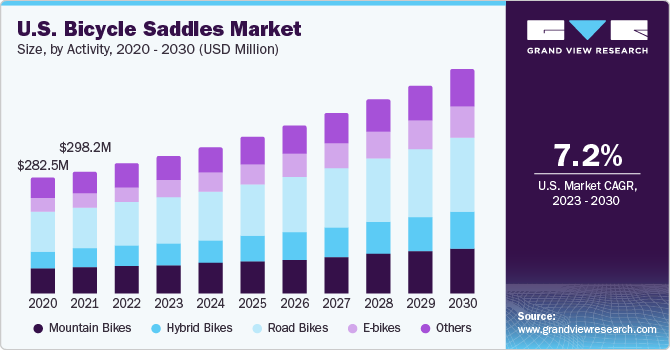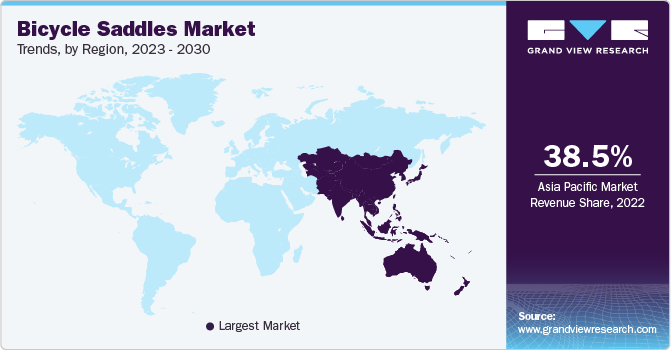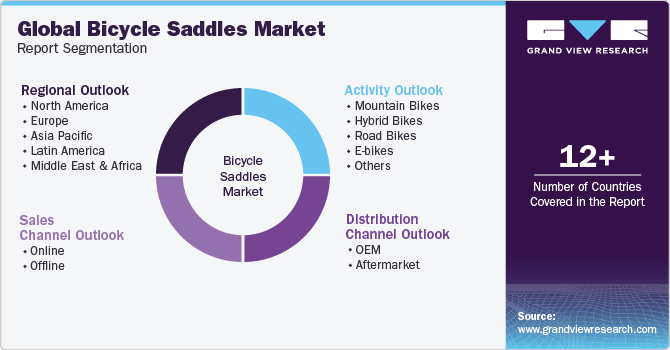- Home
- »
- Automotive & Transportation
- »
-
Bicycle Saddles Market Size, Share & Growth Report, 2030GVR Report cover
![Bicycle Saddles Market Size, Share & Trends Report]()
Bicycle Saddles Market Size, Share & Trends Analysis Report By Activity (Mountain Bikes, Hybrid Bikes, E-bikes), By Distribution Channel (OEM, Aftermarket), By Sales Channel (Online, Offline), By Region, And Segment Forecasts, 2023 - 2030
- Report ID: GVR-4-68040-140-9
- Number of Report Pages: 100
- Format: PDF, Horizon Databook
- Historical Range: 2017 - 2021
- Forecast Period: 2023 - 2030
- Industry: Technology
Bicycle Saddle Market Size & Trends
The global bicycle saddles market size was valued at USD 1.98 billion in 2022 and is expected to grow at a compound annual growth rate (CAGR) of 7.9% from 2023 to 2030. In recent years, the market for bicycle saddles has grown significantly, propelled by a few significant trend aspects. Customers are increasingly looking for saddles that are more comfortable and supportive as they are becoming more aware of the value of ergonomic design. Cycling enthusiasts look for saddles that improve riding comfort and reduce pressure spots, especially for lengthy rides. As a result of the desire for eco-friendly transportation and a healthy way of life, the bicycle industry has expanded. This has increased the demand for high-quality saddles.

Manufacturers of saddles are now able to produce designs that are lighter, more robust, and more performance-enhancing as a result of advancements in materials and technology. Innovative forms, carbon fiber, and gel padding have all drawn customers looking for cutting-edge saddle solutions. The popularity of e-bikes has also carved out a special place for itself in the bicycle saddle industry. Due to the speed and longer rides associated with e-bikes, users frequently have distinct needs when it comes to saddle comfort and support. Specialized e-bike saddles have resulted from this, helping the market to expand.
COVID-19 Impact
After the COVID-19 pandemic, people started using bicycles as a secure and effective form of transportation and recreation as lockdowns and social isolation policies spread. This increase in demand, particularly for commuter and entry-level bikes, stressed supply systems and led to shortages in several areas. Additionally, the closing of physical bicycle stores drove customers to Internet merchants, changing how bicycles and accessories, like saddles, were bought. By increasing production, concentrating on e-commerce methods, and innovating to fulfill cyclists' changing needs, manufacturers responded to these changing dynamics.
Despite these difficulties, the market experienced some impressive improvements. The increased interest in cycling, particularly for health and sustainability reasons, created a growing market for premium saddles designed for comfort and performance. More discerning cyclists started looking for ergonomic features and premium materials. The popularity of e-bikes created a niche market for specialty seats that catered to riders who needed additional features for support and comfort on longer and quicker rides. Future trends in consumer behavior and the industry's dedication to innovation, sustainability, and satisfying the demands of cyclists in the post-pandemic age are projected to affect how the bicycle seats market develops.
Activity Insights
Based on activity, the market is segmented into mountain bikes, hybrid bikes, road bikes, e-bikes, and others. Among these, the road bikes segment dominated with a revenue share of 34.8% in 2022 and is projected to witness a CAGR of 7.5% during the forecast period. Road cyclists look for saddles that offer a seamless fusion of comfort and performance, whether they are professional athletes or enthusiasts. To ensure that riders can maintain comfort over extended rides while improving pedaling efficiency for increased speed and endurance, manufacturers have actively invested in saddle design.
These features include ergonomic elements, lightweight materials, and improved padding technologies. The rise of the road bike saddle market is being fueled by customization options that suit individual preferences and body types, as well as the ease of online shopping, which allows riders to access a wide range of alternatives and read user reviews to make informed choices. As the popularity of road riding grows, so does the demand for specialty saddles designed to meet the specific needs of road bike enthusiasts.
The e-bikes segment is anticipated to grow at the fastest CAGR of 9.8% throughout the forecast period. The surge in e-bike adoption, driven by their electric-assist capabilities, their suitability for commuting, and recreational cycling, has created a distinct niche in the bicycle saddle sector. E-bike riders often face different comfort and support requirements due to the increased speeds and longer rides facilitated by electric assistance. Manufacturers have responded to their needs by developing saddles with greater padding, fewer pressure spots, and increased stability, making riding an e-bike more pleasurable and comfortable.
Sales Channel Insights
Based on sales channel, the market is bifurcated into online and offline. Among these, the offline segment dominated in 2022, gaining a revenue share of 53.8%, and is expected to witness a CAGR of 7.4% during the forecast period. The demand for bicycle saddle through offline sales channels remains robust, despite the growing prevalence of online shopping in the bicycle industry. Brick-and-mortar bicycle shops, sporting goods stores, and cycling specialty retailers continue to serve as essential outlets for cyclists seeking high-quality saddles. These offline sales channels offer customers the advantage of in-person consultations and hands-on experiences, allowing them to physically assess the comfort and fit of saddles before making a purchase.

Moreover, these local retailers often provide valuable expertise, helping cyclists choose the right saddle based on their individual riding needs and body geometry. This personalized service is particularly beneficial for beginners and riders looking for precise guidance. As the bicycle industry evolves with technological advancements, offline sales channels continue to play a vital role in catering to the diverse needs and preferences of cyclists, ensuring that they can access the most suitable saddles for their biking journeys.
The online segment is anticipated to observe significant growth at a CAGR of 8.4% throughout the forecast period. Online retailers, e-commerce websites, and marketplaces have become popular destinations for cyclists seeking a wide range of saddle options. This surge in online demand is attributed to the convenience of browsing and purchasing from one's home, as well as access to a vast array of products, including specialized and niche saddle designs. Customer reviews and recommendations also play a significant role in influencing purchasing decisions, offering insights into the comfort and performance of saddles from fellow cyclists. Furthermore, online sales channels have made it easier for consumers to compare prices, features, and specifications, allowing them to make informed choices and find the best saddle to match their specific riding styles and preferences.
Regional Insights
Asia Pacific led the overall market in 2022, with a revenue share of 38.5%. In recent times, the Asia Pacific region has experienced a notable upswing in the demand for bicycle saddles, influenced by several key factors. One prominent driver is a cultural shift toward embracing healthier and environment-friendly modes of transportation, exemplified by the increasing popularity of cycling across many Asian nations. This shift has created a heightened demand for saddles that prioritize comfort and ergonomic design, enhancing the overall riding experience.

The introduction and increasing popularity of electric bicycles (e-bikes) have further contributed to this demand, as e-bike riders seek specialized saddles tailored to their unique needs. Additionally, the rising middle class in many Asian countries, coupled with higher disposable incomes, has driven the desire for premium and performance-oriented saddles, prompting manufacturers to diversify their offerings. Overall, the Asia Pacific market for bicycle saddles is flourishing, driven by health-conscious lifestyles, the e-bike trend, and the growing middle class's demand for quality cycling equipment.
Europe is anticipated to grow at a CAGR of 8.6% throughout the forecast period. In Europe, the demand for bicycle saddle remains consistently strong, driven by a combination of cultural, environmental, and competitive factors. The continent's deep-rooted cycling tradition, along with well-developed cycling infrastructure in many cities, fuels an ongoing need for comfortable and high-performance saddles catering to a diverse range of cyclists, from daily commuters to professional athletes. With cyclists increasingly acknowledging the pivotal role of saddle ergonomics in realizing their objectives, there persists a demand for inventive saddle designs and advanced materials. Europe continues to have a strong bicycle saddle industry, which reflects the continued attractiveness of cycling as a sensible and ecologically responsible lifestyle choice.
Distribution Channel Insights
Based on distribution channel, the market is bifurcated into OEM and aftermarket. Among these, the OEM segment dominated in 2022, gaining a revenue share of 57.6%, and is expected to witness a CAGR of 7.5% during the forecast period. OEMs play a pivotal role in the production of bicycles, and consequently, their choice of saddles significantly influences the market. When buying seats for their bikes, OEMs frequently look for a balance between cost-effectiveness, personalization, and quality.
OEMs are increasingly searching for saddle makers who can offer a varied selection of solutions to fit different sorts of bicycles, from mountain bikes to urban commuters, as the bicycle business continues to change in response to shifting consumer tastes. By providing OEMs with a variety of materials, designs, and technologies that follow the most recent cycling trends, saddle manufacturers are encouraged to continuously innovate. As a result, bicycles are outfitted with comfortable and performance-improving saddles that satisfy riders' changing needs.
The aftermarket segment is anticipated to observe significant growth at a CAGR of 8.3% throughout the forecast period. Aftermarket consumers, including individual riders and cycling enthusiasts, often seek to upgrade or replace their existing saddles to enhance comfort, performance, and aesthetics. This demand is driven by a desire for personalized riding experiences, whether for road cycling, mountain biking, or other specialized disciplines. The aftermarket saddle market has responded to this by providing a wide range of options, including high-performance saddles with enhanced cushioning, ergonomic forms, and lightweight construction.
Today, cyclists are becoming pickier about saddle ergonomics, materials, and design. Additionally, it is now simpler for them to find and buy aftermarket saddles that best suit their unique riding styles and preferences because of the rising popularity of online retail and the availability of user ratings and recommendations. This pattern is anticipated to continue as the cycling community prioritizes comfort and performance, fostering more innovation and competition in the aftermarket for bicycle saddles.
Key Companies & Market Share Insights
The market is characterized by a mix of established players and innovative newcomers vying for market share. Leading players focus on traditional saddle designs, premium materials, and craftsmanship, catering to cyclists seeking durability and timeless aesthetics. However, newer entrants and smaller manufacturers are introducing innovative saddle designs, utilizing advanced materials, and emphasizing ergonomic features. These players aim to disrupt the market by addressing specific needs, such as enhanced comfort for long-distance riding or specialized saddles for e-bike users.
The market has also witnessed a rise in custom and semi-custom saddle options, allowing riders to tailor their saddles to their unique preferences. Online retailers, alongside traditional brick-and-mortar bike shops, serve as important distribution channels, providing consumers with a wide range of choices. In May 2023, Fizik launched its Antares saddle range which offers more comfort and adaptability. A center cut-out, a sleek low-profile design, and a wider snout are all features of the revised Antares line. These design changes were made to get rid of irritating pressure points, improve rider comfort, and allow more mobility when seated.
Key Bicycle Saddles Companies:
- Bontrager
- Cionlli
- DDK
- Fabric
- Fizik
- Giant Bicycles
- MERIDA BIKES
- Prologo
- Schwinn
- SDG Components
- Selle Italia
- SHIMANO INC.
- Specialized Bicycle Components, Inc.
- Velo
- WTB
Bicycle Saddles Market Report Scope
Report Attribute
Details
Market size value in 2023
USD 2.11 billion
Revenue forecast in 2030
USD 3.58 billion
Growth rate
CAGR of 7.9% from 2023 to 2030
Base year for estimation
2022
Historic year
2017 - 2021
Forecast period
2023 - 2030
Quantitative units
Revenue in USD million/billion and CAGR from 2023 to 2030
Report coverage
Revenue forecast, company ranking, competitive landscape, growth factors, trends
Segments covered
Activity, distribution channel, sales channel, region
Regional scope
North America; Europe; Asia Pacific; Latin America; Middle East & Africa
Country scope
U.S.; Canada; UK; Germany; France; Italy; China; India; Japan; Brazil; Mexico
Key companies profiled
Bontrager; Cionlli; DDK; Fabric; Fizik; Giant Bicycles; MERIDA BIKES; Prologo; Schwinn; SDG Components; Selle Italia; SHIMANO INC.; Specialized Bicycle Components, Inc.; Velo; WTB
Customization scope
Free report customization (equivalent up to 8 analysts working days) with purchase. Addition or alteration to country, regional & segment scope.
Pricing and purchase options
Avail customized purchase options to meet your exact research needs. Explore purchase options
Global Bicycle Saddles Market Report Segmentation
This report forecasts revenue growth at global, regional, and country levels and provides an analysis of the latest industry trends in each of the sub-segments from 2017 to 2030. For this study, Grand View Research has segmented the global bicycle saddles market report based on activity, distribution channel, sales channel, and region:

-
Activity Outlook (Revenue, USD Million, 2017 - 2030)
-
Mountain Bikes
-
Hybrid Bikes
-
Road Bikes
-
E-bikes
-
Others
-
-
Distribution Channel Outlook (Revenue, USD Million, 2017 - 2030)
-
OEM
-
Aftermarket
-
-
Sales Channel Outlook (Revenue, USD Million, 2017 - 2030)
-
Online
-
Offline
-
Bike Store
-
Mass Market Retail Store
-
Sporting Goods Store
-
Others
-
-
-
Regional Outlook (Revenue, USD Million, 2017 - 2030)
-
North America
-
U.S.
-
Canada
-
-
Europe
-
U.K.
-
Germany
-
France
-
Italy
-
-
Asia Pacific
-
China
-
India
-
Japan
-
-
Latin America
-
Brazil
-
Mexico
-
-
Middle East & Africa
-
Frequently Asked Questions About This Report
b. The global bicycle saddles market size was estimated at USD 1.98 billion in 2022 and is expected to reach USD 2.11 billion in 2023.
b. The global bicycle saddles market is expected to witness a compound annual growth rate of 7.9% from 2023 to 2030 to reach USD 3.58 billion by 2030.
b. The road bikes bicycle saddle segment accounted for more than 35% share of the global revenue in 2022. The large share of this segment is attributed to the demand for saddles that offer a seamless fusion of comfort and performance.
b. Some key players operating in the bicycle saddle market include Bontrager, Cionlli, DDK, Fabric, Fizik, Giant Bicycles, MERIDA BIKES, Prologo, Schwinn, SDG Components, Selle Italia, SHIMANO INC., Specialized Bicycle Components, Inc., Velo, and WTB.
b. Key factors that are driving the bicycle saddles market growth include the increasing popularity of cycling as a means of transportation, growing emphasis on leading healthier lifestyles, surge in electric bicycle (e-bike) adoption, and advancements in the manufacture of bicycle saddles using innovative materials.
Share this report with your colleague or friend.
![gvr icn]()
NEED A CUSTOM REPORT?
We can customize every report - free of charge - including purchasing stand-alone sections or country-level reports, as well as offer affordable discounts for start-ups & universities. Contact us now
![Certified Icon]()
We are GDPR and CCPA compliant! Your transaction & personal information is safe and secure. For more details, please read our privacy policy.
We are committed towards customer satisfaction, and quality service.
"The quality of research they have done for us has been excellent."





